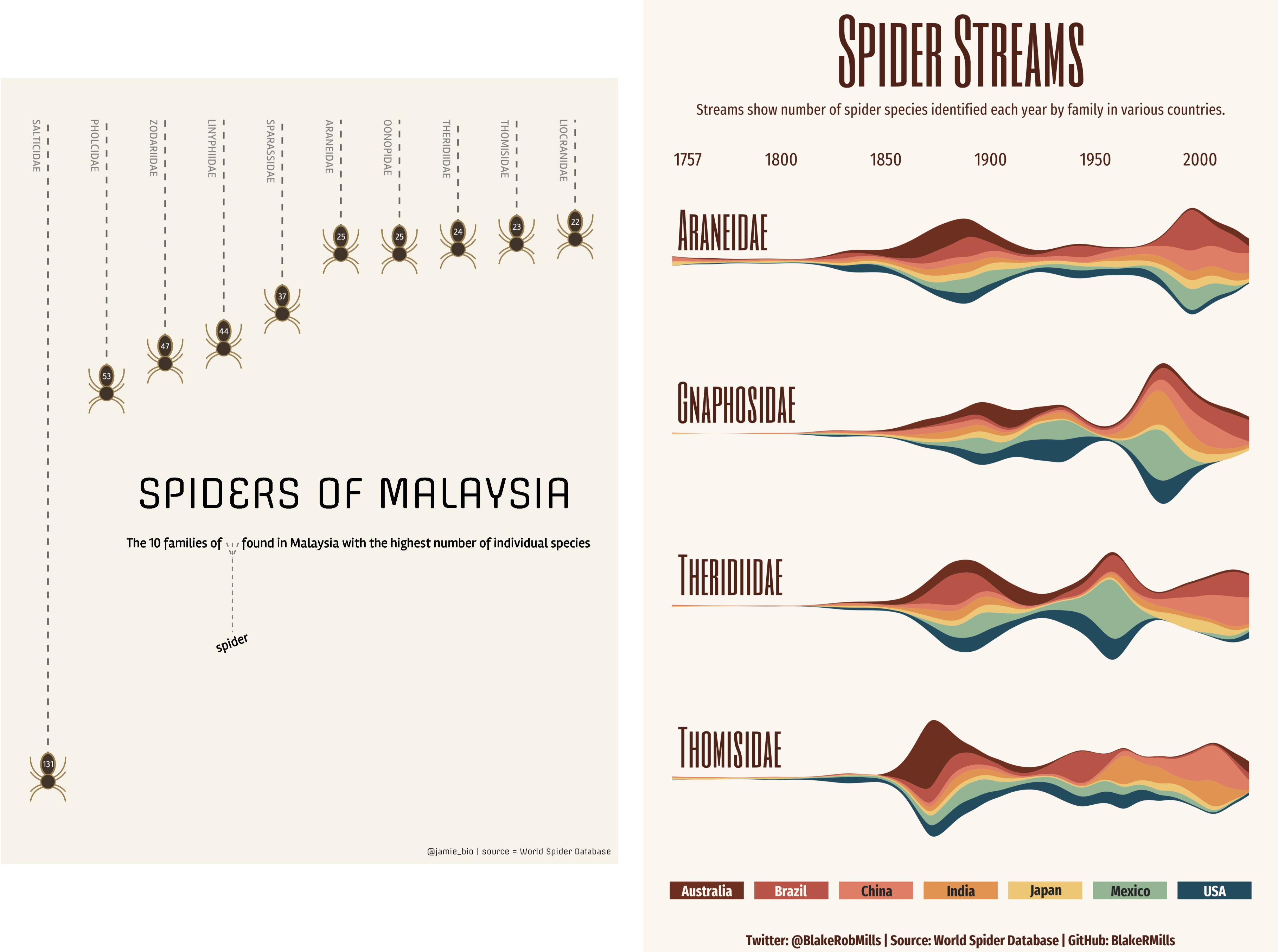Data analysis II
Visualisation
Laurent Bergé
University of Bordeaux, BxSE
09/12/2021
Who am I?
Laurent Bergé
- Assistant Prof., BxSE, Univ. of Bordeaux
- @lrberge
- laurent.berge@u-bordeaux.fr
Data visualization is the art of summarizing information from a data source into a pleasant, non-distorted, informative visual representation. Pleasant and informative: those are the keys to deliver a high-impact message. Miss one of them and nobody will listen. The objective of this course is to give the keys to understand what a good visualization is, and provide some tools to make such visualizations.
The course will cover some theory: we will talk about things such as color, placement, font and how the brain perceives shapes. We will also work our way through the powerful R graphics engine and the ggplot2 library. Throughout this course there will be many small assignments.
What do I do?
My fields
- Applied economics ( = Data + methods)
- Economics of Innovation ( = Large data)
- (a bit of) Statistics ( = Computational methods)
R and me
The story
- I've met R during my master in 2010
- since then... it's a love story
R and me
The story
- I've met R during my master in 2010
- since then... it's a love story
The outcome of our relationship
- 7 packages, 6 of which are public
- the packages cover:
- econometrics
- data handling
- statistical models
- package development
- graphics
This course
Data analysis II
- Data visualization
- Webscraping
Data visualization
This crash course is not...
- really a tutorial on how to make graphs in R
Data visualization
This crash course is not...
- really a tutorial on how to make graphs in R
it's rather about...
opening your eyes on what makes a good statistical graph
learning the tradoffs in graph making
Some resources on graph making in R
ggplot2
Base R
Q: Why do we need data
Q: visualisation?
A: Because numbers suck
Numbers suck
Sort these countries by GDP per capita:
| Country | GDP per capita (US$, ppp) |
|---|---|
| Belgium | 50442.05 |
| France | 45149.10 |
| Germany | 53752.03 |
| Spain | 39907.56 |
| United Kingdom | 45504.84 |
Numbers suck
Sort these countries by GDP per capita:

Numbers suck II
What can you say about these numbers?
| x | y | mean_X | sd_X | mean_Y | sd_Y | cor_XY |
|---|---|---|---|---|---|---|
| 55.4 | 97.2 | 54.3 | 16.8 | 47.8 | 26.9 | -0.0645 |
| 51.5 | 96 | |||||
| 46.2 | 94.5 | |||||
| 42.8 | 91.4 | |||||
| 40.8 | 88.3 | |||||
| 38.7 | 84.9 | |||||
| 35.6 | 79.9 | |||||
| 33.1 | 77.6 | |||||
| ... | ... |

Same measures; but different data ⇒ different stories.

Numbers suck III
Do you see a pattern?
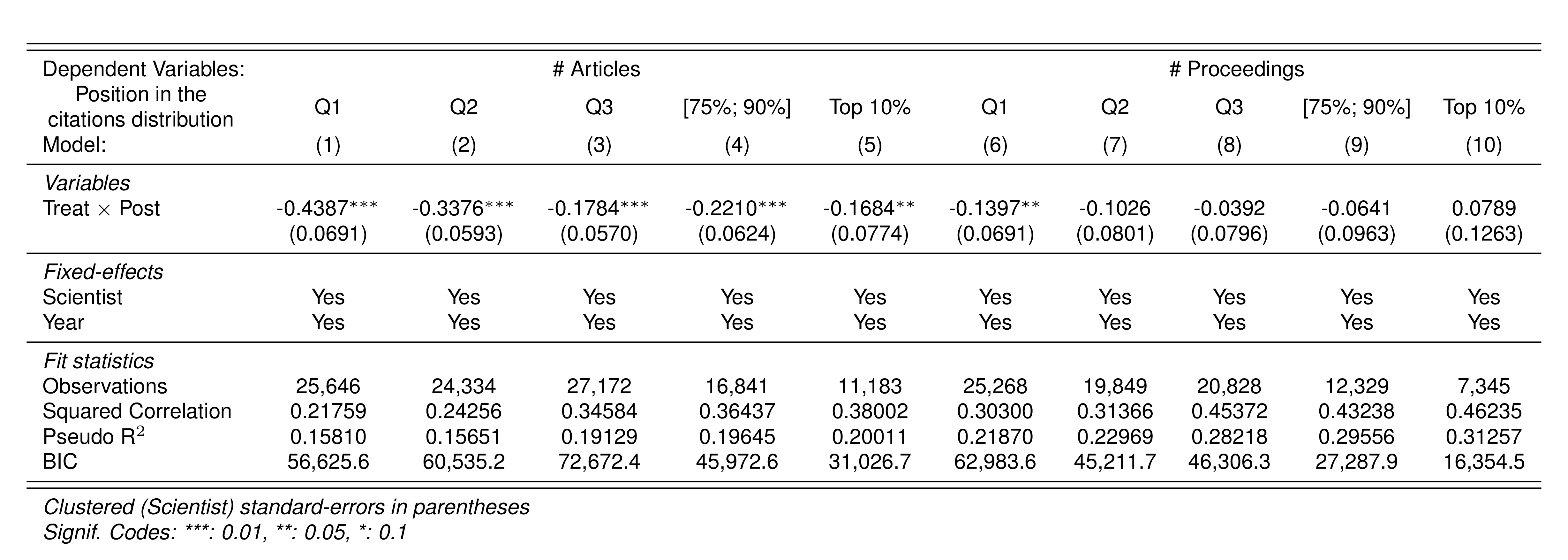
Do you see a pattern?
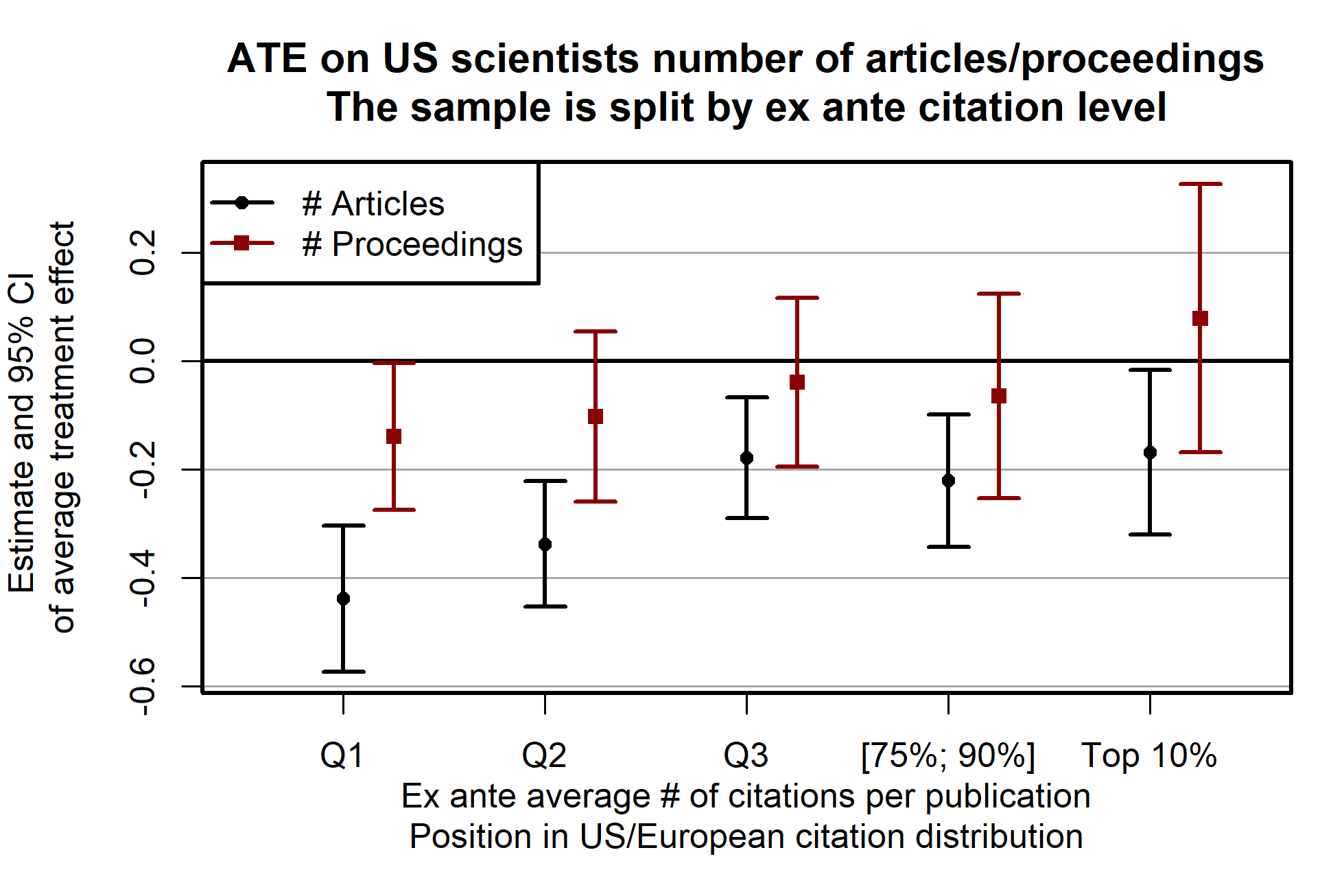
Why should you take visualization
seriously?
No, it's still because numbers suck
remember that we're very limited human beings!
we only can grasp and understand the world with our 5 senses
abstract concepts (e.g. numbers) are tied to these physical senses
No, it's still because numbers suck
remember that we're very limited human beings!
we only can grasp and understand the world with our 5 senses
abstract concepts (e.g. numbers) are tied to these physical senses
to compare numbers we need to visualize them in our head
when we graphically represent numbers, we cut the middle man
Experiment: I give numbers 1, 10, 100, 1000 and tell them to close their eyes
Visualization: why?
powerful way to understand the data
powerful way to send a message (not the same as the previous point!)
most graphs suck (Excel do you hear me?): it's an easy way to stand out
event study graphs next year: many examples of how to make your message impactful based on a set of data the problem is that the students don't see the value of it if they haven't tried hard to make a nice graph so I should give them an assignement in class that they try hard to complete. Only then I can come with theory and advices.
Why R?
- Powerful: imagination is the limit, you can graph anything you have in your mind (really)
Why R?
Powerful: imagination is the limit, you can graph anything you have in your mind (really)
Versatile: there are so many packages...
- Cartography? cartography, leaflet, etc
- 3D + kickass light effects? rayshader
- animated? gganimate
- dynamic? highcharter
Why R?
Powerful: imagination is the limit, you can graph anything you have in your mind (really)
Versatile: there are so many packages...
- Cartography? cartography, leaflet, etc
- 3D + kickass light effects? rayshader
- animated? gganimate
- dynamic? highcharter
Communication: smooth integration in HTML documents, create a website in minutes (Rmarkdown)
Small gallery of nice graphs
Maps
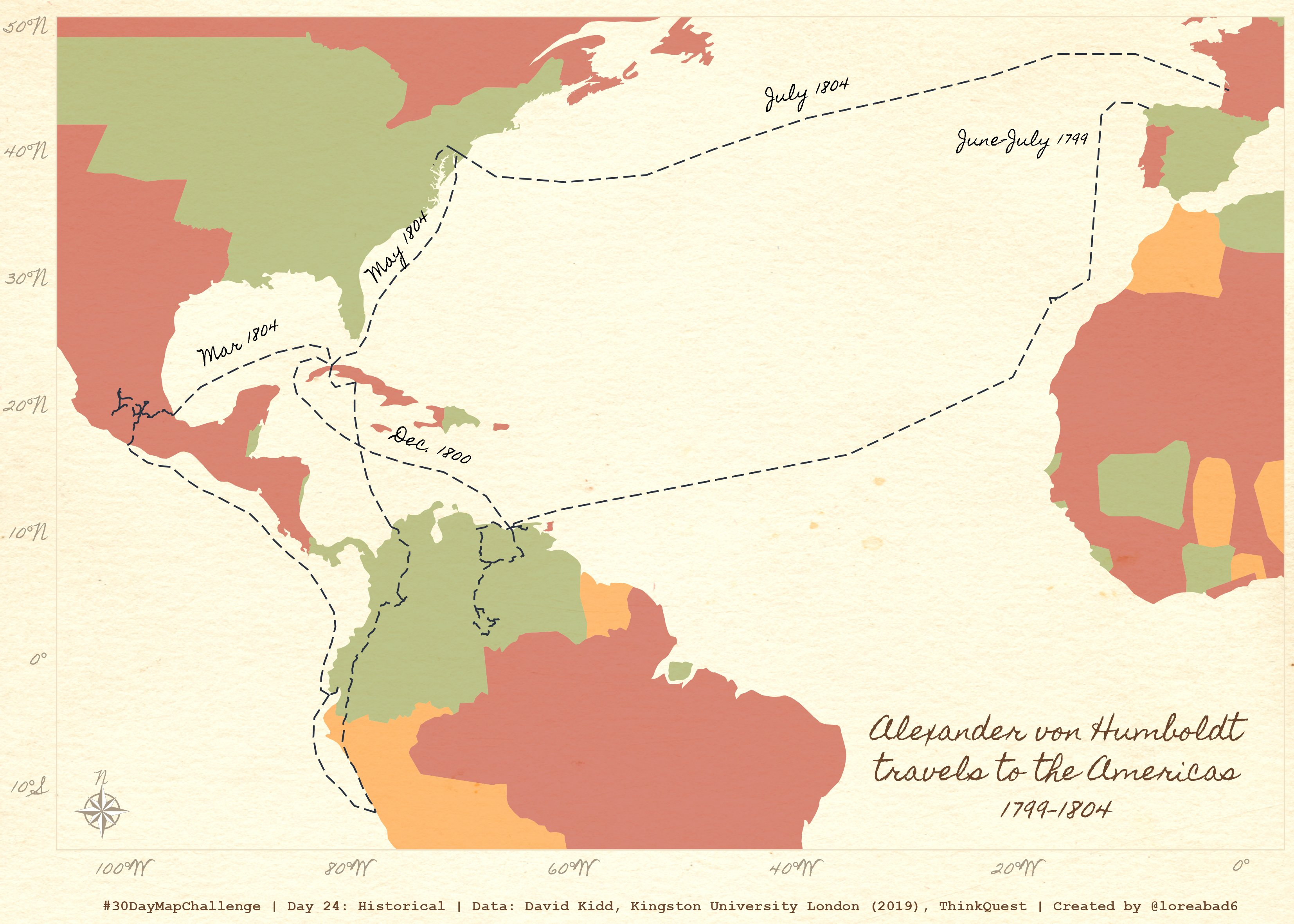
# David Kidd, Kingston University London (2019)# https://storymaps.arcgis.com/stories/79eeffa9f54d429687c17fa8267d3ba2# Thinkquest historical boundaries 1815#https://web.archive.org/web/20080328104539/http://library.thinkquest.org:80/C006628/download.htmllibrary(tidyverse)library(sf)library(ggpomological)library(ggimage)library(MapColoring)library(ggspatial)extrafont::loadfonts(device = "win")humboldt = read_sf("data/kingstonUniLondon/humboldt_route.geojson") |> filter(Journey == "America") |> mutate( angle = case_when( Date == "June-July 1799" ~ 0, Date == "Dec. 1800" ~ 340, Date == "Mar 1804" ~ 25, Date == "May 1804" ~ 50, Date == "July 1804" ~ 10, is.na(Date) ~ NA_real_ ), hjust = case_when( Date == "June-July 1799" ~ 1.1, Date == "Dec. 1800" ~ -0.3, Date == "Mar 1804" ~ 0.5, Date == "May 1804" ~ 0.5, Date == "July 1804" ~0.5, is.na(Date) ~ NA_real_ ), vjust = case_when( Date == "June-July 1799" ~ 3.5, Date == "Dec. 1800" ~ 0.5, Date == "Mar 1804" ~ 0.6, Date == "May 1804" ~ 0.5, Date == "July 1804" ~0.5, is.na(Date) ~ NA_real_ ) )countries = read_sf("data/thinkquest/1815/cntry1815.shp") |> st_set_crs(4326) |> mutate(fillcol = as.factor(getColoring(as_Spatial(countries)))) |> st_transform(st_crs(humboldt))bbox = humboldt |> st_bbox()g = ggplot() + geom_sf(data = countries, aes(fill = fillcol), col = NA, alpha = 0.6, show.legend = FALSE ) + geom_sf( data = humboldt, linetype = "longdash", color = "#2b323f", size = 0.5 ) + geom_sf_text( data = humboldt, aes(label = Date, angle = angle, hjust = hjust, vjust = vjust), family = "Homemade Apple", nudge_y = 250000 ) + annotation_north_arrow( style = north_arrow_nautical( line_col = "#a89985", text_family = "Homemade Apple", text_col = "#a89985", fill = c("#a89985", "white"), ) ) + annotate( "text", x = -1500000, y = -900000, color = "#6b452b", family = "Homemade Apple", size = 5, label = "Alexander von Humboldt\ntravels to the Americas\n1799-1804" ) + scale_fill_pomological() + labs( caption = glue::glue( "#30DayMapChallenge | Day 24: Historical | ", "Data: David Kidd, Kingston University London (2019), ThinkQuest | Created by @loreabad6", ) ) + coord_sf( xlim = c(bbox["xmin"], bbox["xmax"]), ylim = c(bbox["ymin"], bbox["ymax"]) ) + labs(x = NULL, y = NULL) + theme_pomological("Homemade Apple", 16) + theme( plot.caption = element_text( family = "mono", size = 9, hjust = 0.5, color = "#6b452b", face = "bold" ) )ggbackground(g, ggpomological:::pomological_images("background"))ggsave(filename = "maps/day24.png", height = 20, width = 28, units = "cm")Animations
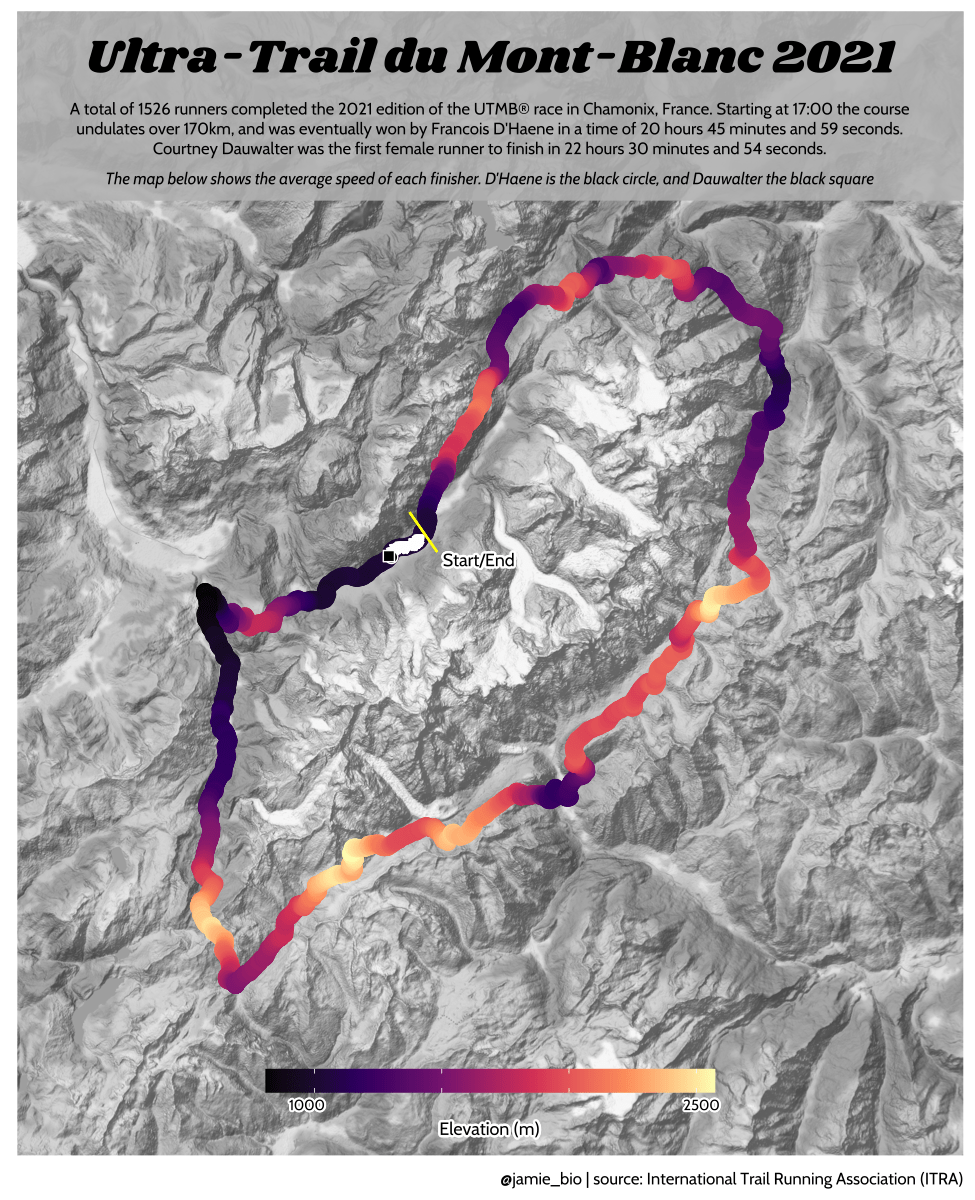
# ultra_running.R# Jamie Hudson# Created: 27 October 2021# Edited: 27 October 2021# Data: Benjamin Nowak by way of International Trail Running Association (ITRA)# load libraries ------------------------------------------------------------library(tidytuesdayR)library(tidyverse)library(janitor)library(ggmap)library(XML)library(gganimate)library(showtext)library(colorspace)library(ggtext)library(shadowtext)font_add_google("Cabin")font_add_google("Shrikhand")showtext_opts(dpi = 320)showtext_auto(enable = TRUE)# load dataset ------------------------------------------------------------ultra_rankings <- readr::read_csv('https://t.co/JNJTpFTKqI?amp=1') %>% clean_names()race <- readr::read_csv('https://raw.githubusercontent.com/rfordatascience/tidytuesday/master/data/2021/2021-10-26/race.csv')# read in GTX data for UTMB course # code from Sascha Wolfer https://www.r-bloggers.com/2014/09/stay-on-track-plotting-gps-tracks-with-r/# data from https://www.plotaroute.com/search?keyword=utmboptions(digits=10)# Parse the GPX filepfile <- htmlTreeParse(file = "data/UTMB.gpx", error = function(...) {}, useInternalNodes = T)elevations <- as.numeric(xpathSApply(pfile, path = "//trkpt/ele", xmlValue))times <- xpathSApply(pfile, path = "//trkpt/time", xmlValue)coords <- xpathSApply(pfile, path = "//trkpt", xmlAttrs)lats <- as.numeric(coords["lat",])lons <- as.numeric(coords["lon",])# wrangle data ------------------------------------------------------------race_df <- full_join(ultra_rankings, race)utmb_21 <- race_df %>% filter(race_year_id == 72496)geodf <- data.frame(lat = lats, lon = lons, ele = elevations, time = times)lat <- c(min(geodf$lat) -0.06, max(geodf$lat) + 0.1)lon <- c(min(geodf$lon) - 0.1, max(geodf$lon) + 0.1)bbox <- make_bbox(lon,lat)geodf <- geodf %>% slice(which(row_number() %% 5 == 1))utmb_times <- utmb_21 %>% dplyr::select(time_in_seconds) %>% mutate(pos = row_number()) %>% pivot_wider(names_from = pos, values_from = time_in_seconds) %>% slice(rep(1, each = nrow(geodf)))# function to repeat times n timesrep.x <- function(x, na.rm=FALSE) (x / nrow(geodf) * row_number())geodf_times <- cbind(geodf, utmb_times) %>% dplyr::select(-c("time")) %>% mutate_at(.vars = vars("1":"1526"), rep.x) %>% pivot_longer(-c(lon, lat, ele), names_to = "id", values_to = "time") %>% mutate(time = as.numeric(time))# D'Haene and Dauwaltertwo_runners <- geodf_times %>% filter(id %in% c(1,7))# dataframe of routeroute <- geodf %>% dplyr::select(lon, lat, ele)# download stamenmap for backgroundmap_background <- get_stamenmap(bbox, zoom = 12, source="stamen", maptype = "terrain-background", color="bw")# plot ------------------------------------------------------------plot <- ggmap(map_background) + geom_path(data = route, mapping = aes(x = lon, y = lat, color = ele, group = 1), size = 4, lineend = "round") + scale_color_viridis_c(option = "magma") + geom_rect(xmin = 6.5, xmax = 7.3, ymin = 46.09, ymax = 46.2, fill = "grey", alpha = 0.4) + geom_jitter(geodf_times, mapping = aes(x = lon, y = lat, group = id), colour = "white", fill = "white", pch = 25, size = 0.4, width = 0.002, height = 0.002) + geom_jitter(two_runners, mapping = aes(x = lon, y = lat, group = id), colour = "white", fill = "black", pch = rep(c(21, 22), 2858), size = 2.5, width = 0.002, height = 0.002) + geom_segment(aes(x = route$lon[1] - 0.01, y = route$lat[1] + 0.01, xend = route$lon[1] + 0.01, yend = route$lat[1] - 0.01), colour = "yellow") + geom_shadowtext(label = "Start/End", x = route$lon[1] + 0.014, y = route$lat[1] - 0.014, size = 3, hjust = 0, family = "Cabin", check_overlap = TRUE, colour = "black", bg.colour = "white", bg.r = 0.2) + geom_shadowtext(label = "Elevation (m)", x = 6.917, y = 45.623, size = 3, hjust = 0.5, family = "Cabin", check_overlap = TRUE, colour = "black", bg.colour = "white", bg.r = 0.2) + geom_shadowtext(label = "1000", x = 6.785, y = 45.635, size = 2.5, hjust = 0.5, family = "Cabin", check_overlap = TRUE, colour = "black", bg.colour = "white", bg.r = 0.2) + geom_shadowtext(label = "2500", x = 7.07, y = 45.635, size = 2.5, hjust = 0.5, family = "Cabin", check_overlap = TRUE, colour = "black", bg.colour = "white", bg.r = 0.2) + guides(colour = guide_colorbar(title.position = 'bottom', title.hjust = 0.5, barwidth = unit(15, 'lines'), barheight = unit(0.8, 'lines'))) + annotate(geom = "text", label = "Ultra-Trail du Mont-Blanc 2021", x = 6.917, y = 46.162, size = 8, hjust = 0.5, family = "Shrikhand") + annotate(geom = "richtext", label = "A total of 1526 runners completed the 2021 edition of the UTMB® race in Chamonix, France. Starting at 17:00 the course \nundulates over 170km, and was eventually won by Francois D'Haene in a time of 20 hours 45 minutes and 59 seconds. \nCourtney Dauwalter was the first female runner to finish in 22 hours 30 minutes and 54 seconds.", x = 6.917, y = 46.125, size = 2.8, hjust = 0.5, family = "Cabin", fill = NA, label.color = NA) + annotate(geom = "richtext", label = "*The map below shows the average speed of each finisher. D'Haene is the black circle, and Dauwalter the black square*", x = 6.917, y = 46.1, size = 2.8, hjust = 0.5, family = "Cabin", fill = NA, label.color = NA) + labs(colour = "Elevation (m)", caption = "@jamie_bio | source: International Trail Running Association (ITRA)") + theme_minimal() + theme( axis.line = element_blank(), axis.text.x = element_blank(), axis.text.y = element_blank(), axis.ticks = element_blank(), axis.title.x = element_blank(), axis.title.y = element_blank(), panel.grid.major = element_blank(), panel.grid.minor = element_blank(), panel.border = element_blank(), plot.caption = element_text(family = "Cabin", size = 8), legend.position=c(0.5, 0.025), legend.justification = "bottom", legend.direction = "horizontal", legend.text = element_blank(), legend.title = element_blank())anim <- plot + transition_reveal(time)animate(anim, nframes = 200, height = 8, width = 6.5, units = "in", res = 150)anim_save(paste0("ultra_running_", format(Sys.time(), "%d%m%Y"), ".gif"))Purpose of a graph
Good graphs have a main purpose.
Purpose of a graph
Good graphs have a main purpose.
Main purposes:
looking nice
send a message
exploratory
Purpose of a publication graph
Good graphs have a main purpose.
Main purposes:
looking nice
send a message ( = we're here!)
exploratory
Graph theory
Publication graph
What's the best graph?
- informative ( = clear and not misleading)
- pleasant
Publication graph
What's the best graph?
- informative ( = clear and not misleading)
- pleasant
But...
- the medium should not take precedence on the content!
- graphs which are too beautiful (too arty) distract the reader from the message
informative: get the information quickly and unambiguously
pleasant: looks nice -- hard to tell
stacking information is good but can reduce clarity there are ways to stack information w/t reducing too much clarity: colors / forms
Maybe too nice?

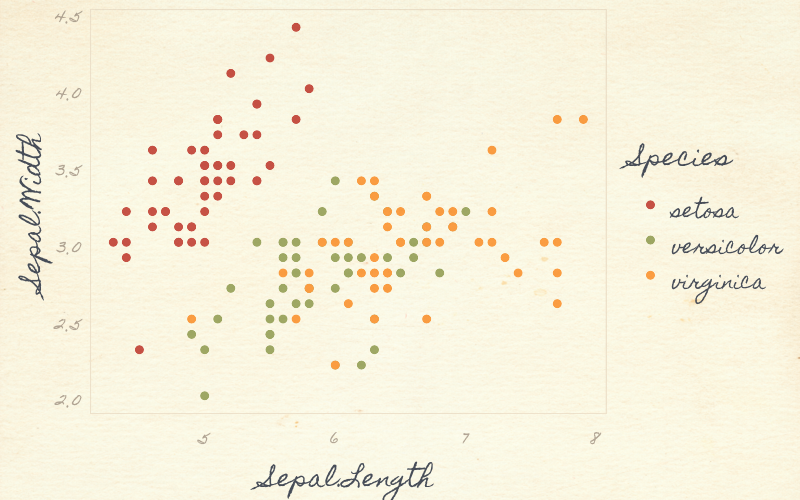
The 3 components of a graph
content
clarity
attractiveness
Content
the information you want to share/observe
typically: relationships, time series, consequence of events, conditional distributions
you can stack several content in the same graph
Clarity
how easy it is to understand the content
defined by its measure: the time it takes to extract a piece of information ⇒ the lower the time, the higher the clarity
Attractiveness
is the graph pleasant to look at?
do you stare at it for its own sake?
Graphs as a maths problem
Graph making is just about optimization
Precision approach (us)
graph∗=argmaxgclarity(g)s.t.content(g)≥τattractiveness(g)≥η
Graphs as a maths problem
Graph making is just about optimization
Precision approach (us)
graph∗=argmaxgclarity(g)s.t.content(g)≥τattractiveness(g)≥η
Infography approach
graph∗=argmaxgattractiveness(g)s.t.content(g)≥τclarity(g)≥γ
Tradeoffs
adding content necessarily reduces clarity (there are solutions to limit that)
the relationship between attractiveness and content/clarity is not clear. Graphs which are visually too attractive usually reduce clarity or weaken the message.
Example (iris again)


the contrast is so so due to the grey background: ↘ clarity
the colors are OK to identify the species
the grid helps to make comparisons between distant points
⇒ clarity is OK overall but the attractiveness is so so. We get that these variables are good to discriminate the species: content is OK.


font hard to read ↘ clarity
no grid ↘ clarity
it is visually attractive (at least to me!):
- the font is nice (although hard to read)
- the background texture is nice
- the pencil look of the numbers/box is nice
- = it's really nice!
⇒ attractiveness +++ (to me!). However, because there are so many nice things to look at, we lose track of the content. The design choices, although great, reduce clarity greatly.
This is not a graph that you should put in your report!
Golden rules of writing graph making
- Thou shalt not expect the reader to be interested in what you do
Golden rules of writing graph making
Thou shalt not expect the reader to be interested in what you do
Thou shalt not expect the reader to spend more than 5 seconds on your graph
Lessons of the rules
Clarity is cardinal
what is this graph about?
what does it represent?
what's the value of that point?
a graph should be self explanatory
Lessons of the rules
Clarity is cardinal
what is this graph about?
what does it represent?
what's the value of that point?
a graph should be self explanatory
Attractiveness is important, but second tier
hooks the reader
makes the reader stay longer and maybe decide to put in some efforts to understand your graph
clarity: think it that way: there is a threshold of effort above which the reader will just stop
attractiveness: that's why infographics in newspapers are so nice: to hook the uninterested reader
The reader as a shopper
The money is the effort. The reader has little money.
The reader as a shopper
The money is the effort. The reader has little money.
Clarity = value for money
you can extract more content with lower effort
if you don't get much for your money, you just switch to another product
The reader as a shopper
The money is the effort. The reader has little money.
Clarity = value for money
you can extract more content with lower effort
if you don't get much for your money, you just switch to another product
Attractiveness: increases the amount of money you wanna spend. It's the same effect as advertising:
Buy that ticket to become a millionaire!vsBuy that ticket and you may become a millionaire if you win a lottery with probability one over one billion.
Typology of graphs
For publication (i.e. for the world)
- low content: to send a single or two messages
- clarity should be maximal: the reader must understand fast
- high attractiveness: to hook the reader
Typology of graphs
For publication (i.e. for the world)
- low content: to send a single or two messages
- clarity should be maximal: the reader must understand fast
- high attractiveness: to hook the reader
For exploration (i.e. for yourself)
- high content: you want the most information in a single graph
- tolerance for lower clarity: you know what you're doing, that's the price to pay to dispose of more content in a single graph. Although you still need a minimum of clarity
- attractiveness: isn't the priority
Typology of graphs
For publication (i.e. for the world)
- low content: to send a single or two messages
- clarity should be maximal: the reader must understand fast
- high attractiveness: to hook the reader
For exploration (i.e. for yourself)
- high content: you want the most information in a single graph
- tolerance for lower clarity: you know what you're doing, that's the price to pay to dispose of more content in a single graph. Although you still need a minimum of clarity
- attractiveness: isn't the priority
You still have the same optimization problem to solve but the thresholds are different!
How to solve the optimization
problem?
content
clarity
attractiveness
Attractiveness
what is considered nice largely depends on a consensus which can evolve over time
it depends on preferences that vary between persons and even within persons (just have a look at your haircuts of 10 years ago!)
we won't cover attractiveness since we can't please everyone
Attractiveness
what is considered nice largely depends on a consensus which can evolve over time
it depends on preferences that vary between persons and even within persons (just have a look at your haircuts of 10 years ago!)
we won't cover attractiveness since we can't please everyone
But...
there are guiding principles of proportions and colors
good news: clear graphs usually look ok
content
clarity
attractiveness
Content
tailor your content, ask yourself:
- is that information important?
- what would the graph look like without it?
- cut anything not necessary
add elements of context if needed (do they strengthen your point?)
is the graph faithful?
hierarchy of information! (the main message should be emphasized vàv other messages/the elements of context)
do I get the takeaway just from looking at the graph? Or do I need to read the text / get an oral explanation to get the central message?
next year => add examples for each of those cases => very important to add concrete example : make an exercise in class of having to graph an idea, and come with these concepts afterwards (so that the students can see what it really means)
content
clarity
attractiveness
Clarity
The good news
There are many tips to make graphs clear!
What humans are good at
- discerning colors
What humans are good at
discerning colors
discerning shapes
What humans are good at
discerning colors
discerning shapes
heights comparisons
What humans are good at
discerning colors
discerning shapes
heights comparisons
Let's leverage these three properties to make good graphs!
graphe avec et sand grille horizontale graph étroit => OK grphe large => difficile de comparer
Colors
- colors are extremely powerful: used properly, they add an extra layer of information without requiring any extra graph-space and have almost no processing cost for the reader
Colors
- colors are extremely powerful: used properly, they add an extra layer of information without requiring any extra graph-space and have almost no processing cost for the reader
Moral of the story: Abuse colors!
Colors: what for?
two main uses of color:
- to distinguish categories
- to represent intensity
Colors: what for?
two main uses of color:
- to distinguish categories
- to represent intensity
two different usages = two very different color picks!
Colors: OK, but which colors?
Colors: a tricky topic!
Colors: a mini primer
Colors can be decomposed in
- Hue
- Saturation
- Lightness
Colors: a mini primer
Colors can be decomposed in
- Hue
- Saturation
- Lightness
Hue
- pure color
Saturation
- quantity of grey added to the color
- 100: only grey
- 100: no grey
Lightness
- quantity of black (<50) or white (>50) added to the color
- 100: black
- 150: pure color
- 100: white
Colors: general rule
Don't use pure colors!
Colors: general rule
Don't use pure colors!
They're a bit of an eyesore. They're very bright, making them hard to read. That's why I had to use a heavy font.⋆ Note that the brightness depends on the hue: hues are not equal light-wise!
Colors: general rule
Don't use pure colors!
They're a bit of an eyesore. They're very bright, making them hard to read. That's why I had to use a heavy font.⋆ Note that the brightness depends on the hue: hues are not equal light-wise!
These are the same hues. I've just reduced saturation. The text is easier to read. I can even remove the heavy font!
Colors: distinguishing categories
use colors that are "different" but have some harmony
how to find harmonious color sets?
Colors: distinguishing categories
use colors that are "different" but have some harmony
how to find harmonious color sets?
Don't do it yourself!
Adobe color website: to create palettes or to find existing ones
Distinct colors: 3 rules
General rules (and like French grammar, there are always exceptions!)
- use colors that are "clear-cut" (we keep colors in mind using their names, ex: using blue + mid-blue-mid-green + green makes it hard to remember)
Distinct colors: 3 rules
General rules (and like French grammar, there are always exceptions!)
use colors that are "clear-cut" (we keep colors in mind using their names, ex: using blue + mid-blue-mid-green + green makes it hard to remember)
use different hues, not only different shades (shade variations are harder to remember and discern than hue variations; having both is even better)
Distinct colors: 3 rules
General rules (and like French grammar, there are always exceptions!)
use colors that are "clear-cut" (we keep colors in mind using their names, ex: using blue + mid-blue-mid-green + green makes it hard to remember)
use different hues, not only different shades (shade variations are harder to remember and discern than hue variations; having both is even better)
don't use colors to distinguish too many categories:
- 2-4: best
- 2-5: to avoid, but can be OK if palette is good and depends on the graph
- 2>5: forget about it (too big a hit on clarity)
1) pple remind the colors with their names, hence a color that is mid blue/mid green is harder to remember that stg blue. IF TIME => show two palettes with these differences
2) Same comment, don't use shades of a same hue, light blue/dark blue => hard to remember IF TIME => show two palettes with these differences
IF TIME: 4 panes: one with the names and associated colors, then the graph same set of two but with clear cut colors
3) What to do if I have 5+ categories to display? Cut content! In general, if you have a graph with 5+ categories to display, ask yourself if there's not a problem in terms of content
Distinct colors: Rule 3
OK, but what if I really have to display 6+ categories?
Distinct colors: Rule 3
OK, but what if I really have to display 6+ categories?

Distinct colors: Example
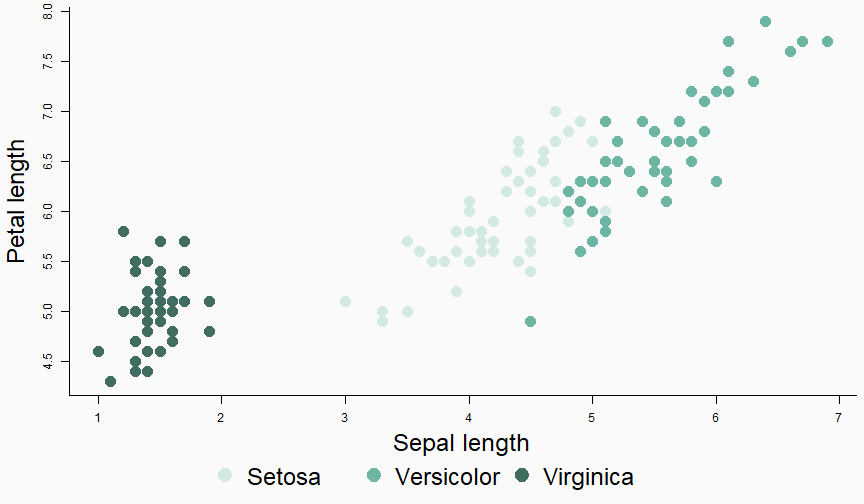
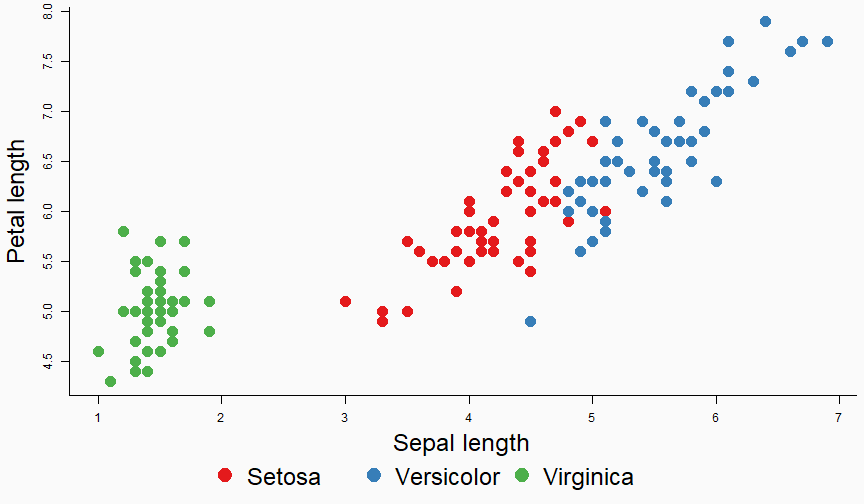
Colors: intensity
Two main types of things to represent:
- min-max: dichotomic representation (you can use >2 colors though)
- negative-zero-positive: at least three colors (dichromatic works well)
A) things with positive values only: unemployment, earnings, whatever
B) correlation, deviations from the mean, etc
Colors: intensity
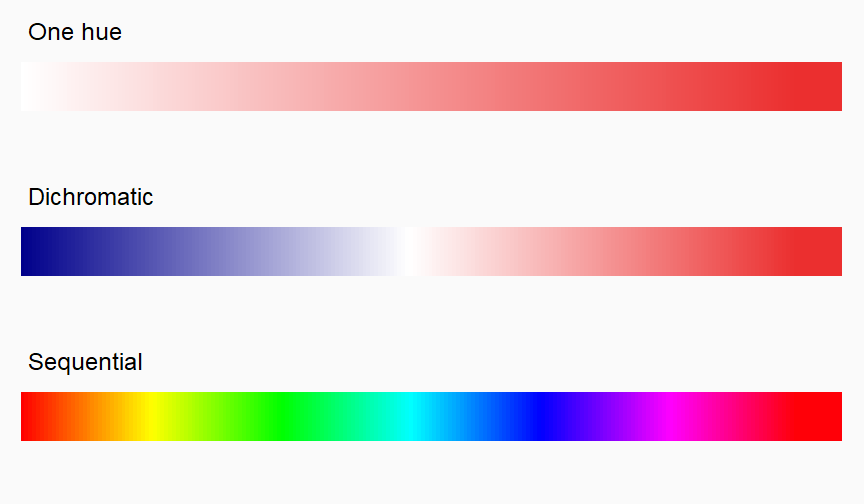


Source for the numbers: https://www.colorblindguide.com/post/colorblind-people-population-live-counter
mostly men: 8% women: 1/200
The main consequence is that there is no silver bullet to represent discrete color points
Color accessibility


Shapes
- it's fairly easy for humans to discern shapes
- however it's more difficult and less automatic than for colours
- add shapes in scatterplots in conjunction with colours to facilitate reading
- very useful in B&W
Shapes: example




Harnessing visual perception
- humans are pretty good at comparing heights and widths
- in contrast, they're pretty bad at comparing surfaces
⇒ use bars to compare numbers, use a grid to help make comparisons
Comparisons: Example
Can you see a difference?

Exactly the same data... incomparably easier to read.

Pie charts can be good to show big discrepancies--but that's illustration then. For precise statistical graphs, forget about it.
If you have many categorical values to display, vertical bar graphs can be good.
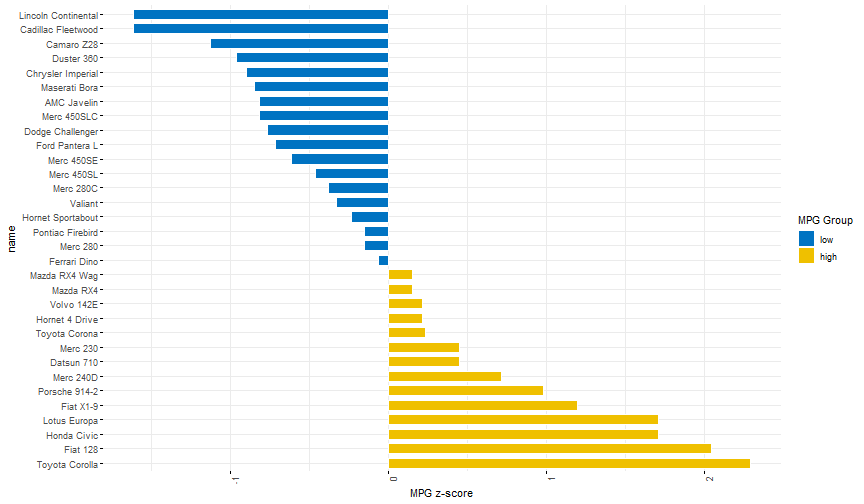
although too much content will always be hard to read. The solution is to cut out the cars that are not important in our study or make a single group of them. => In the future I should also take care of explaining how to curate the content to sharpen the message.
Clarity: Helping the reader
Helping the reader
- the data in your graph is central
- the text describing the graph is not less central!
Helping the reader
- the data in your graph is central
- the text describing the graph is not less central!
Without description, a graph is worthless!
Describing a graph: First commandment
You must absolutely ALWAYS label your axes, or else you'll endure divine wrath!1
Describing a graph: Other main textual components
- the legend, if there are 2+ types of data
- the title1
Describing a graph: Other main textual components
- the legend, if there are 2+ types of data
- the title1
Text takes space, and space is limited! The text should be as short as possible while remaining as informative as possible.
Helping the reader: Tips
- the text must be read easily: readable font + min. font size
Helping the reader: Tips
the text must be read easily: readable font + min. font size
hierarchy: the explanations should not take more space than the data. More important information should be more emphasized.
Helping the reader: Tips
the text must be read easily: readable font + min. font size
hierarchy: the explanations should not take more space than the data. More important information should be more emphasized.
repeat information
Helping the reader: Tips
the text must be read easily: readable font + min. font size
hierarchy: the explanations should not take more space than the data. More important information should be more emphasized.
repeat information
add a grid when relevant
Helping the reader: Tips
the text must be read easily: readable font + min. font size
hierarchy: the explanations should not take more space than the data. More important information should be more emphasized.
repeat information
add a grid when relevant
minimize the distance between the legend and the data: especially with 4+ categories
Making the text easy to read
- you must choose a readable font
- ensure the size of the text is easily readable (but not too big)
Font family
There are three main font families:
- serif
- sans-serif
- monospace
- sans-serif are recognized as the font family with the highest readability
- in general, don't use serif fonts in graphs.
- mono fonts can be nice when you have words with the same size that stack (like country codes)
In R you can change the font in graphs with showtext:
pacman::p_load(showtext)font_add_google("Fira Code", "fira")font_add_google("Merriweather", "merri")showtext_auto()plot(iris$Petal.Length, iris$Sepal.Length, col = iris$Species, pch = 16, bty = "L", ann = FALSE)title(xlab = "Petal length (default sans serif)", cex.lab = 1.2)title(ylab = "Sepal length (serif: Merriweather)", family = "merri", cex.lab = 1.2)mtext(text = "Three varieties of iris flowers (mono: Fira Code)", side = 3, line = 1, font = 2, adj = 0, cex = 1.7, family = "fira")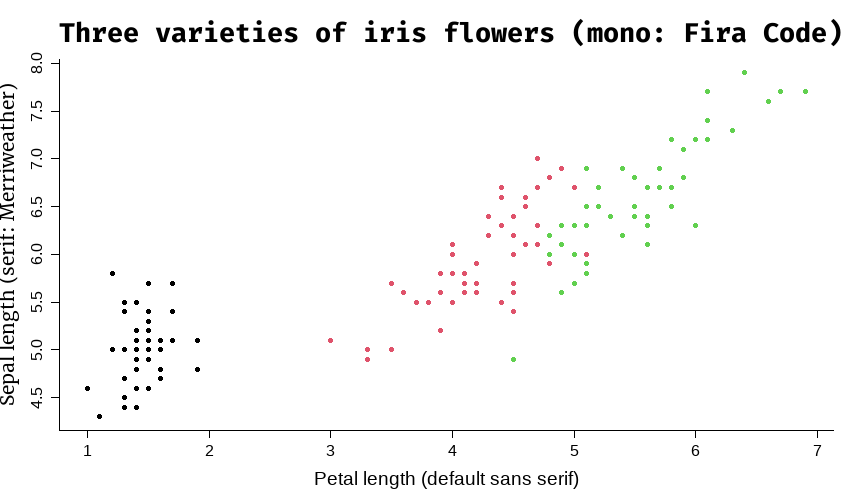
Font size
- do you think that once you find a graph displaying nicely on your screen, you can just
ggsaveit and it will be fine?
Font size
- do you think that once you find a graph displaying nicely on your screen, you can just
ggsaveit and it will be fine?
Think twice!
Font size
- do you think that once you find a graph displaying nicely on your screen, you can just
ggsaveit and it will be fine?
Think twice!
- the final location of your graph is your document, not your screen!
- the graph will be rescaled to fit its width in the document ⇒ the font may become too small!
Font size: A helper function
Some functions may help you to deal with that: pdf_fit/png_fit from fplot:
- use
setFplot_pageto define the size of the final document if needed (by default it's an A4 page with some usual margins)
# starts recording.# - pt = 11 will save the graph with 11pt font size# - w2h = 1.75 means that the width to height ratio is 1.75 (wide graph)pdf_fit("path.pdf", pt = 11, w2h = 1.75)# your graph# ends recording.# The final look of your graph is displayed in the viewer panefit_off()Repeat + grid: An example
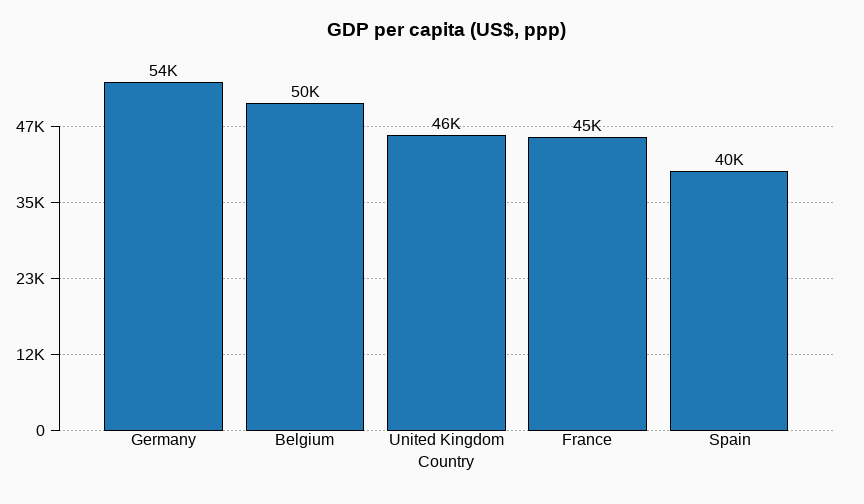
Minimize the legend-to-data distance


Can you spot the problems?
I will show you a graph coming from a top (top) publication.
The research was careful and the results are of great relevance: there is no doubt on the quality and the importance of the research done.
Despite the stellar work, the graphs could be improved (i.e. ↗ clarity), at no cost.
Among others...
The legend takes as much space as the graph!!!!!!!! (it burned my eyes!)
Adding a light grid would facilitate the reading, it's almost impossible to compare points.
